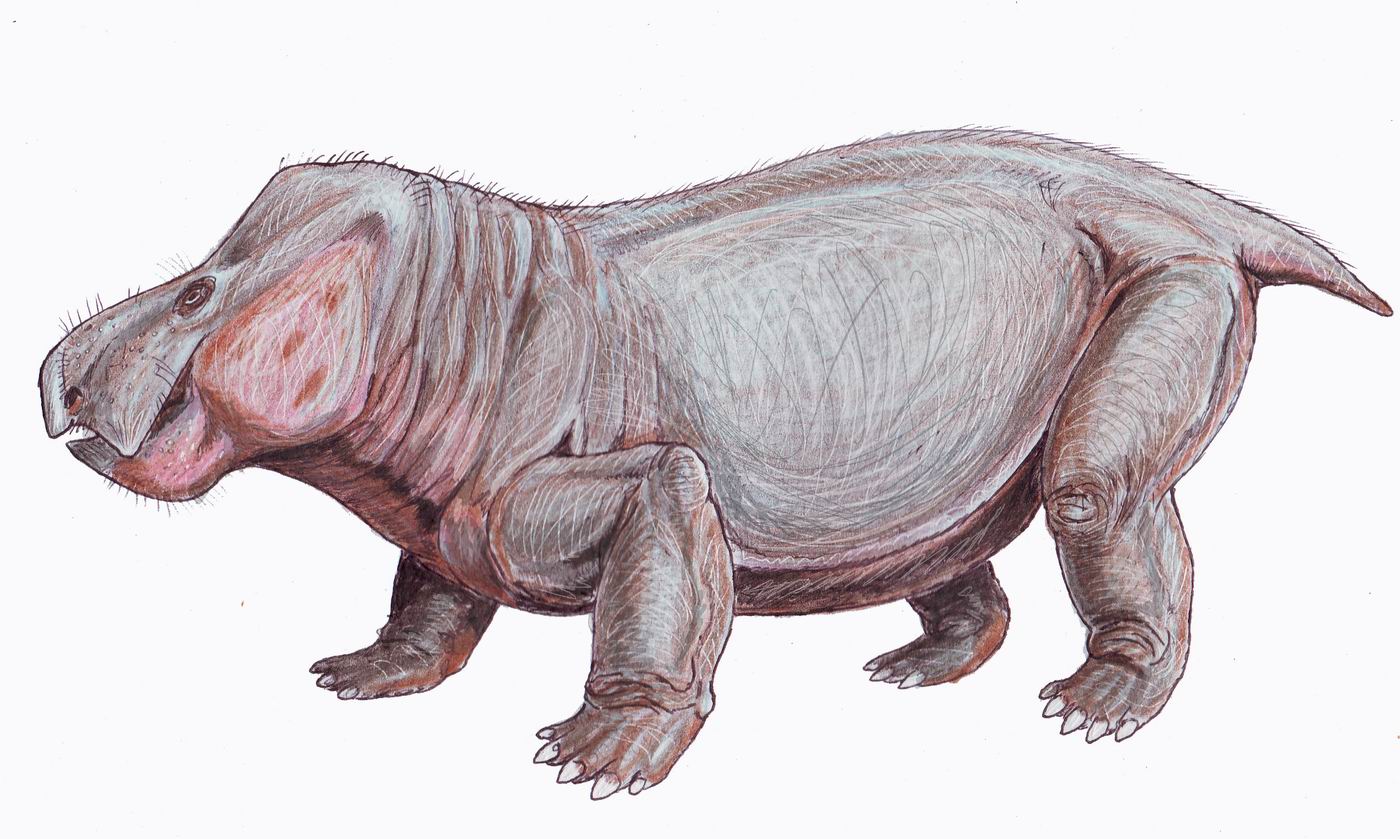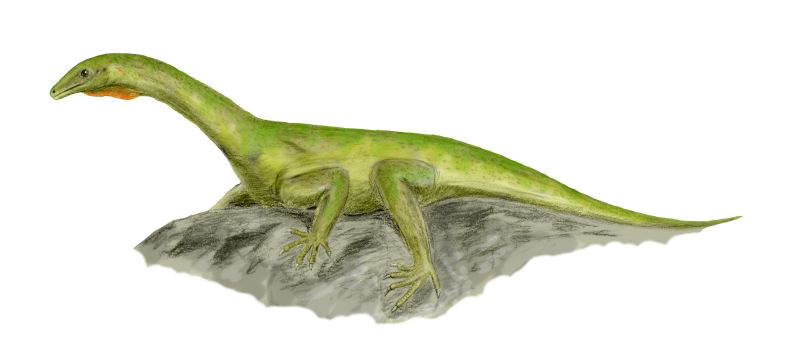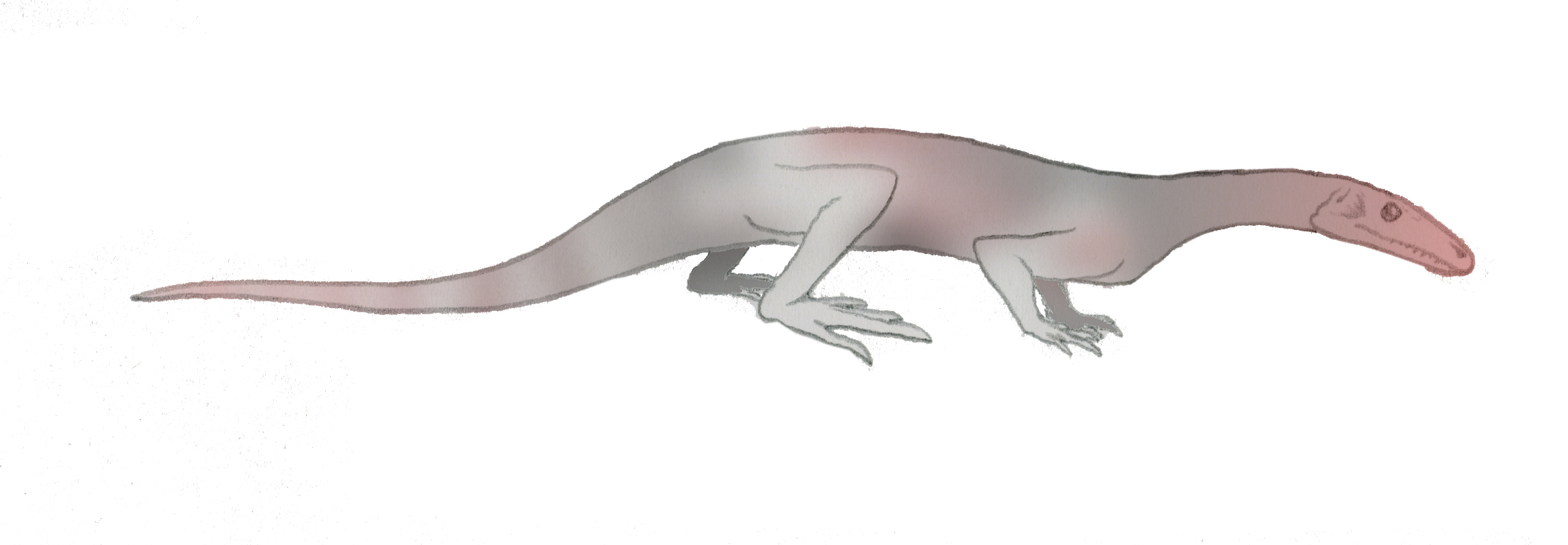|
Pamelaria
''Pamelaria'' is an extinct genus of allokotosaurian archosauromorph reptile known from a single species, ''Pamelaria dolichotrachela'', from the Middle Triassic of India. ''Pamelaria'' has sprawling legs, a long neck, and a pointed skull with nostrils positioned at the very tip of the snout. Among early archosauromorphs, ''Pamelaria'' is most similar to ''Prolacerta'' from the Early Triassic of South Africa and Antarctica. Both have been placed in the family Prolacertidae. ''Pamelaria'', ''Prolacerta'', and various other Permo-Triassic reptiles such as ''Protorosaurus'' and ''Tanystropheus'' have often been placed in a group of archosauromorphs called Protorosauria (alternatively called Prolacertiformes), which was regarded as one of the most basal group of archosauromorphs. However, more recent phylogenetic analyses indicate that ''Pamelaria'' and ''Prolacerta'' are more closely related to Archosauriformes than are ''Protorosaurus'', ''Tanystropheus'', and other protorosaurs, ... [...More Info...] [...Related Items...] OR: [Wikipedia] [Google] [Baidu] |
Pamelaria Scale Diagram
''Pamelaria'' is an extinct genus of allokotosaurian archosauromorph reptile known from a single species, ''Pamelaria dolichotrachela'', from the Middle Triassic of India. ''Pamelaria'' has sprawling legs, a long neck, and a pointed skull with nostrils positioned at the very tip of the snout. Among early archosauromorphs, ''Pamelaria'' is most similar to '' Prolacerta'' from the Early Triassic of South Africa and Antarctica. Both have been placed in the family Prolacertidae. ''Pamelaria'', ''Prolacerta'', and various other Permo-Triassic reptiles such as '' Protorosaurus'' and '' Tanystropheus'' have often been placed in a group of archosauromorphs called Protorosauria (alternatively called Prolacertiformes), which was regarded as one of the most basal group of archosauromorphs. However, more recent phylogenetic analyses indicate that ''Pamelaria'' and ''Prolacerta'' are more closely related to Archosauriformes than are ''Protorosaurus'', ''Tanystropheus'', and other protorosa ... [...More Info...] [...Related Items...] OR: [Wikipedia] [Google] [Baidu] |
Allokotosauria
Allokotosauria is a clade of early archosauromorph reptiles from the Middle to Late Triassic known from Asia, Africa, North America and Europe. Allokotosauria was first described and named when a new monophyletic grouping of specialized herbivorous archosauromorphs was recovered by Sterling J. Nesbitt, John J. Flynn, Adam C. Pritchard, J. Michael Parrish, Lovasoa Ranivoharimanana and André R. Wyss in 2015. The name Allokotosauria is derived from Greek meaning "strange reptiles" in reference to unexpected grouping of early archosauromorph with a high disparity of features typically associated with herbivory. History Nesbitt ''et al.'' (2015) defined the group as a stem-based taxon containing ''Azendohsaurus madagaskarensis'' and '' Trilophosaurus buettneri'' and all taxa more closely related to them than to ''Tanystropheus longobardicus'', ''Proterosuchus fergusi'', ''Protorosaurus speneri'' or ''Rhynchosaurus articeps''. Therefore, Allokotosauria includes the families Azendoh ... [...More Info...] [...Related Items...] OR: [Wikipedia] [Google] [Baidu] |
Azendohsaurus
''Azendohsaurus'' is an extinct genus of herbivorous archosauromorph reptile from roughly the late Middle to early Late Triassic Period of Morocco and Madagascar. The type species, ''Azendohsaurus laaroussii'', was described and named by Jean-Michel Dutuit in 1972 based on partial jaw fragments and some teeth from Morocco. A second species from Madagascar, ''A. madagaskarensis'', was first described in 2010 by John J. Flynn and colleagues from a multitude of specimens representing almost the entire skeleton. The generic name "Azendoh lizard" is for the village of Azendoh, a local village near where it was first discovered in the Atlas Mountains. It was a bulky quadruped that unlike other early archosauromorphs had a relatively short tail and robust limbs that were held in an odd mix of sprawled hind limbs and raised forelimbs. It had a long neck and a proportionately small head with remarkably sauropod-like jaws and teeth. ''Azendohsaurus'' used to be classified as a herbivorous ... [...More Info...] [...Related Items...] OR: [Wikipedia] [Google] [Baidu] |
Yerrapalli Formation
The Yerrapalli Formation is a Triassic rock formation consisting primarily of mudstones that outcrops in the Pranhita–Godavari Basin in southeastern India. The Yerrapalli Formation preserves fossils of freshwater and terrestrial vertebrates as well as trace fossils of invertebrates.Yerrapalli Formation at Fossilworks.org The fauna includes amphibians, |
Archosauromorph
Archosauromorpha (Greek for "ruling lizard forms") is a clade of diapsid reptiles containing all reptiles more closely related to archosaurs (such as crocodilians and dinosaurs, including birds) rather than lepidosaurs (such as tuataras, lizards, and snakes). Archosauromorphs first appeared during the late Middle Permian or Late Permian, though they became much more common and diverse during the Triassic period. Although Archosauromorpha was first named in 1946, its membership did not become well-established until the 1980s. Currently Archosauromorpha encompasses four main groups of reptiles: the stocky, herbivorous allokotosaurs and rhynchosaurs, the hugely diverse Archosauriformes, and a polyphyletic grouping of various long-necked reptiles including ''Protorosaurus'', tanystropheids, and ''Prolacerta''. Other groups including pantestudines (turtles and their extinct relatives) and the semiaquatic choristoderes have also been placed in Archosauromorpha by some authors. A ... [...More Info...] [...Related Items...] OR: [Wikipedia] [Google] [Baidu] |
Protorosauria
Protorosauria is an extinct polyphyletic group of archosauromorph reptiles from the latest Middle Permian (Capitanian stage) to the end of the Late Triassic (Rhaetian stage) of Asia, Europe and North America. It was named by the English anatomist and paleontologist Thomas Henry Huxley in 1871 as an order, originally to solely contain ''Protorosaurus''. Other names which were once considered equivalent to Protorosauria include Prolacertiformes and Prolacertilia. Protorosaurs are distinguished by their long necks formed by elongated cervical vertebrae, which have ribs that extend backward to the vertebrae behind them. Protorosaurs also have a gap between the quadrate bones and the jugal bones in the back of the skull near the jaw joint, making their skulls resemble those of lizards. While previously thought to be monophyletic, the group is now though to consist of various groups of basal archosauromorph reptiles that lie outside Crocopoda. Classification Protorosauria was consi ... [...More Info...] [...Related Items...] OR: [Wikipedia] [Google] [Baidu] |
Prolacertidae
Prolacertidae is an extinct family of archosauromorph reptiles that lived during the Early Triassic epoch. It was named in 1935 by the British palaeontologist Francis Rex Parrington to include the species ''Prolacerta broomi'' of South Africa and Antarctica. In 1979 a second species, '' Kadimakara australiensis'', was described from Australia. Several other genera, such as ''Macrocnemus'', ''Pamelaria'' and ''Prolacertoides'', have also been assigned to this family in the past, but these have been placed elsewhere by later studies, leaving ''Prolacerta'' and ''Kadimakara'' as the only well-supported members. The prolacertids were historically placed within the paraphyletic group Prolacertiformes along with other basal, long-necked archosauriforms like ''Protorosaurus'' and the tanystropheids. However, more recent research has shown that the prolacertids were only distantly related to other "prolacertiforms", and were instead among the closest relatives of Archosauriformes. The c ... [...More Info...] [...Related Items...] OR: [Wikipedia] [Google] [Baidu] |
Prolacerta
''Prolacerta'' is a genus of archosauromorph from the lower Triassic of South Africa and Antarctica. The only known species is ''Prolacerta broomi''. The generic name ''Prolacerta'' is derived from Latin meaning “before lizard” and its species name ''broomi'' is in commemoration of the famous paleontologist Robert Broom, who discovered and studied many of the fossils found in rocks of the Karoo Supergroup. When first discovered, ''Prolacerta'' was considered to be ancestral to modern lizards, scientifically known as lacertilians. However, a study by Gow (1975) instead found that it shared more similarities with the lineage that would lead to archosaurs such as crocodilians and dinosaurs (including birds). ''Prolacerta'' is considered by modern paleontologists to be among the closest relatives of the Archosauriformes. History of discovery ''Prolacerta'' was first described by Francis Rex Parrington in 1935 from a single skull recovered near the small town, Middelburg, in the ... [...More Info...] [...Related Items...] OR: [Wikipedia] [Google] [Baidu] |
Trilophosauridae
Trilophosaurs are lizard-like Triassic allokotosaur reptiles related to the archosaurs. The best known genus is ''Trilophosaurus'', a herbivore up to long. It had a short, unusually heavily built skull, equipped with massive, broad flattened cheek teeth with sharp shearing surfaces for cutting up tough plant material. Teeth are absent from the premaxilla and front of the lower jaw, which in life were probably equipped with a horny beak. The skull is also unusual in that the lower temporal fenestra, temporal opening is missing, giving the appearance of a euryapsida, euryapsid skull, and originally the Trilophosaurs were classified with placodonts and sauropterygia. Carroll (1988) suggests that the lower opening may have been lost to strengthen the skull. Trilophosaurs are so far known only from the Late Triassic of North America and Europe. Below is a cladogram showing the phylogenetic relationships of Trilophosauridae within Archosauromorpha as recovered by Nesbitt ''et al.' ... [...More Info...] [...Related Items...] OR: [Wikipedia] [Google] [Baidu] |
Cervical Vertebrae
In tetrapods, cervical vertebrae (singular: vertebra) are the vertebrae of the neck, immediately below the skull. Truncal vertebrae (divided into thoracic and lumbar vertebrae in mammals) lie caudal (toward the tail) of cervical vertebrae. In sauropsid species, the cervical vertebrae bear cervical ribs. In lizards and saurischian dinosaurs, the cervical ribs are large; in birds, they are small and completely fused to the vertebrae. The vertebral transverse processes of mammals are homologous to the cervical ribs of other amniotes. Most mammals have seven cervical vertebrae, with the only three known exceptions being the manatee with six, the two-toed sloth with five or six, and the three-toed sloth with nine. In humans, cervical vertebrae are the smallest of the true vertebrae and can be readily distinguished from those of the thoracic or lumbar regions by the presence of a foramen (hole) in each transverse process, through which the vertebral artery, vertebral veins, an ... [...More Info...] [...Related Items...] OR: [Wikipedia] [Google] [Baidu] |
Pectoral Girdle
The shoulder girdle or pectoral girdle is the set of bones in the appendicular skeleton which connects to the arm on each side. In humans it consists of the clavicle and scapula; in those species with three bones in the shoulder, it consists of the clavicle, scapula, and coracoid. Some mammalian species (such as the dog and the horse) have only the scapula. The pectoral girdles are to the upper limbs as the pelvic girdle is to the lower limbs; the girdles are the parts of the appendicular skeleton that anchor the appendages to the axial skeleton. In humans, the only true anatomical joints between the shoulder girdle and the axial skeleton are the sternoclavicular joints on each side. No anatomical joint exists between each scapula and the rib cage; instead the muscular connection or physiological joint between the two permits great mobility of the shoulder girdle compared to the compact pelvic girdle; because the upper limb is not usually involved in weight bearing, its stabilit ... [...More Info...] [...Related Items...] OR: [Wikipedia] [Google] [Baidu] |
Naris
A nostril (or naris , plural ''nares'' ) is either of the two orifices of the nose. They enable the entry and exit of air and other gasses through the nasal cavities. In birds and mammals, they contain branched bones or cartilages called turbinates, whose function is to warm air on inhalation and remove moisture on exhalation. Fish do not breathe through noses, but they do have two (but cyclostomes have merged into one) small holes used for smelling, which can also be referred to as nostrils. In humans, the nasal cycle is the normal ultradian cycle of each nostril's blood vessels becoming engorged in swelling, then shrinking. The nostrils are separated by the septum. The septum can sometimes be deviated, causing one nostril to appear larger than the other. With extreme damage to the septum and columella, the two nostrils are no longer separated and form a single larger external opening. Like other tetrapods, humans have two external nostrils (anterior nares) and two addi ... [...More Info...] [...Related Items...] OR: [Wikipedia] [Google] [Baidu] |






.jpg)
